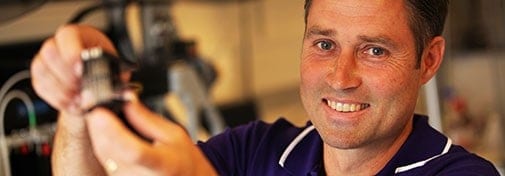The world’s most widespread test for ovarian cancer reports false-positives in 94 of 100 diagnosed cases. Now, chemists at the University of Copenhagen working with clinical researchers at University College London have developed a method able to halve the number of false-positives. When fully developed, the new test will spare a significant number of women from unnecessary worry and further testing. Furthermore, global health care providers stand to save substantial sums – just by including a test on a certain sugar molecule in tandem with the currently prevailing diagnostic test.
Collaboration between chemist and cancer specialists
Ola Blixt is a chemical glycobiology professor at the Department of Chemistry, University of Copenhagen. He and Professor Usha Menon have led the research efforts of the teams at the Gynaecological Cancer Research Centre, University College London and the Copenhagen Center for Glycomics, University of Copenhagen, who have succeeded in developing this new method that tests for ovarian cancer.
The method helps distinguish between cancer and otherwise benign conditions and is called glycoprofiling. It has been published in the esteemed Journal of Proteome Research, under the title “Microarray Glycoprofiling of CA125 Improves Differential Diagnosis of Ovarian Cancer”.
Vital to clear misdiagnosed women
Ola Blixt hopes that glycoprofiling will be incorporated in prevailing ovarian cancer diagnostics “kits” because there is simply so much distress that follows in the wake of a false diagnosis.
“When a woman is informed that she might have cancer, she will always be terrified. She will also require further testing and this can be uncomfortable. Furthermore, there is the risk that she will encounter a considerable wait time before being provided with an accurate answer. I think that it is vital to clear those women who are misdiagnosed with cancer in a quick and safe manner. Our researches suggests that the new method, glycoprofiling, could improve differential diagnosis and significantly reduce the number of patients elected for further testing,” says Blixt.
Test targets markers elevated by benign conditions too
Three-percent of all women will be tested for ovarian cancer in their lifetimes. In the United States alone, every year 100,000 women receive the distressing message that they might have cancer, following the initial test.
Women with ovarian cancer have an elevated amount of a protein known as CA125 in their blood. Therefore, current tests focus on this protein. Unfortunately, a wide range of other and far more benign conditions also increases CA125 figures. These include benign cysts, infections and even menstruation and pregnancy.
Sugar transformed by cancer
Ola Blixt directs the new diagnostic tests at an entirely different biological molecule, namely a sugar that coats the surface of the CA125 protein. Blixt explains that the presence of this specific sugar is limited to women who really are affected by ovarian cancer.
“All proteins have a type of sugar-coat – small, complicated sugar molecules that reside on a protein’s surface. When cancer is present in the body, we can observe a chemical change in this sugar-coat. It is a very complex phenomenon. Luckily, it is very simple to investigate and determine the presence of this transformed sugar coating,” states Blixt.
Unpatented discovery allows for immediate integration
In principle, the sugar testers could be included in the currently prevalent diagnostic kits immediately. In the lab, Blixt and his PhD student, Kowa Chen, tested a plant lectin and and a monoclonal antibody. Both serve to reveal the specific sugar, and both are cheap and easy to get a hold of. The way is even cleared for willing manufacturers, explains Blixt.
“We have decided to publish these results, as opposed to taking out a patent. OK, we won’t get rich, even though the market related to ovarian cancer is worth 170 million dollars annually. On the other hand, any manufacturer is able to include this in their existing kit. And I hope that it happens soon,” says Blixt.
Paying a debt to ailing contributors
In the glycoprofiling project, Blixt and Chen worked with Professor Usha Menon and Dr Gentry Maharaj to analyse samples gathered in the UK Ovarian Cancer Population Study (UKOPS). Blixt feels indebted to the women who contributed their blood samples to the research.
“Each of these samples has a sad story behind it. Our results can’t help those women who provided us with the tests, but we owe it to the women to try to get our method out as far and wide as possible, so that their sacrifice has not been in vain,” says Blixt. In time, Blixt expects the glycoprofiling method to improve diagnoses for a range of other cancer types. “But I’m just a university researcher. We have demonstrated a method that works. Now companies must pick up the ball and refine it,” concludes Professor Blixt.


